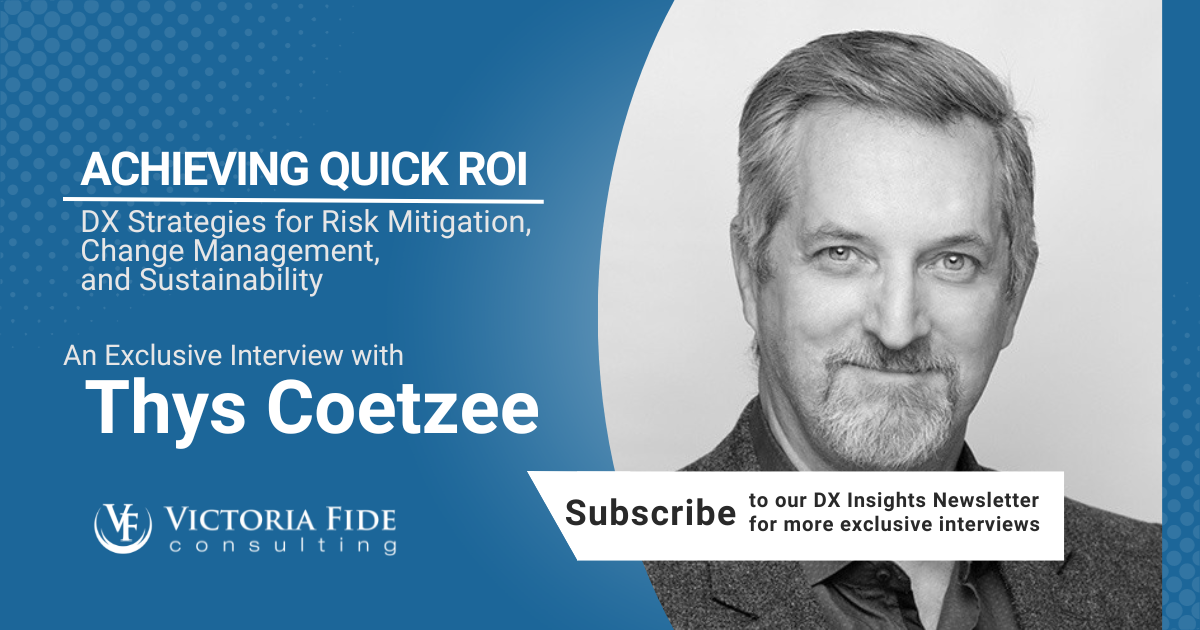
Thys Coetzee is a seasoned professional with expertise in mergers and acquisitions, project management, and cross-functional collaboration across various sectors, including technology, engineering, manufacturing, and business strategy.
Having lived on four continents and worked across seven, Thys excels at bridging diverse cultures and disciplines to achieve organizational goals on time and within budget. He specializes in helping leadership teams implement their vision and execute projects for growth and profitability, while prioritizing people-centered strategies. His ability to craft actionable plans to enhance staff engagement and company performance while considering budget constraints makes him a valuable strategic partner.

Today, Thys serves as Senior Director – Transformation at WithoutWire Inventory Sciences. In this interview, Thys provides insights into digital transformation drawn from his experience uniting experts in a cross-functional environment.
Q: Can you describe the role that digital transformation plays in the delivery of environmentally friendly water management solutions?
Digital transformations support activities across water management systems generally. In data acquisition, analysis and control, these tools provide continuous monitoring of conditions with intelligent responses, optimizing utilization of resources, protecting the environment and equipment and aiding in management and maintenance. With improved, secure communication tools designed to fail over safely in the event of power or connectivity issues, data is aggregated on secure servers where statistical analyses can examine issues widely, improving from chasing the needle responses on isolated gear to providing early alerts across wider systems.
Q: What future technological trends do you predict for water management solutions, and will AI play a pivotal role?
We are already employing data aggregation and edge computing in the water industry, working hard at penetrating the market and knowing there is a very long way to go to take advantage of even current technologies. Artificial Intelligence (AI) represents the next level of computing horsepower and access to massive amounts of data at unprecedented levels.
We will see many fights about data ownership, usage, restrictions, and rights and the removal thereof that will impact usage over the next few years. The utility industries move slow enough and make sufficient incremental improvements with the existing automation improvements to give AI enough time to mature in these areas.
Q: What is the biggest roadblock you have encountered when integrating digital solutions into existing legacy systems?
Two major areas of conflict arise: First, the data acquisition networks, and second the data itself.
The data acquisition networks and the corporate networks clash in a number of areas. IT structures are very protective of their environments, and rightly so. Security is at the forefront, especially of high-risk areas such as our utilities infrastructure. Add to this the vulnerability created by the longevity of some systems and their installations pre-dating the era of preparedness against cyber-attacks. There are cases where the only defense is total isolation from remote access, and even limiting physical access. Very carefully established relationships of trust are needed between vendors and clients to manage these systems. Change is slow and automation will lag as a result.
Secondly, the data itself becomes an issue. There are regulatory issues around moving data across various boundaries, and there are corporate policies about data moving off the corporate networks. It is necessary for there to be some kind of tracing to ensure actions are taken correctly. The compute effort is in the cloud and that means the data must move to be accessible. Analyses would examine huge data warehouses, meaning the data could be used in a context outside of the corporation.
Q: How can leaders navigate the change management process to facilitate smooth adoption and mitigate employee resistance to new digital tools?
Change, adoption of new ideas, progress, improvement… handling these is a core part of an organization’s culture. People can’t be changed – they have to change themselves. It takes leadership to present a vision that embraces and welcomes change as necessary to get from the present to the future, to engage people in that vision, and to create an environment in which change can occur.
Senior leadership needs to foster an environment of progress, where the status quo is always seen as the opposite of growth and where improvement is the order of the day. Allied with this is the transparency to present thoughts, to expand and investigate the thinking, and the authority to execute. Good people will embrace the vision and become part of the culture.
Q: How do you balance the substantial upfront investment of digital transformation with the long-term benefits, especially with varying economic conditions in play?
ROI is fundamental, let’s make no bones about that. So is risk – risk of doing and risk associated with not doing. Those thoughts aside, the easiest way to mitigate financial impact is to shorten the time to achieving benefits. The old, cumbersome drawn-out processes are a killer. It takes so long and costs so much to discover flaws.
When undertaking business process optimization, it is prudent to take small bites, swallow or spit, don’t choke, and take another bite. Fail fast, before you throw time and resources down endless rabbit holes. I understand this is a somewhat simplistic view of some very large transformations, but really think about how transformation is a continuous effort versus a stepwise function. Get on the right track, and then keep moving. Even if you are on the right track, coasting will get you an express train in the caboose!
This ties in with the culture of change. We have all seen those ERP projects where a business leader decides everyone suddenly has to document all their procedures, usually after years of accepted work for ISO or something similar, but they discover they missed mountains of details in their flow charts. Most of those processes are an utter waste of time, with steps added to overcome issues in old versions, dealing with abrogated regulations, staff shortages at some point, or simply someone running off at a tangent.
IT, usually stuck with gluing it all together but with little ability to question the business thinking, takes the rap for delivering exactly what the business asked for. Rather, business leaders must spend the time identifying the desired outcome and then ask the SMEs how the transformation will hit that outcome. Stop crippling new systems with old habits.
Excessive customizations have a huge impact on timelines and business performance, and they never stop costing money. Maintenance upgrades are postponed because customizations may break. I’m talking about maintenance across the board, from underlying operating systems through to security updates. It is usually cheaper and easier to change a business procedure to match an out-of-the box process in the software, even if some retraining is needed. Put those sacred cows on the barbeque! This again goes back to a culture of change and growth versus stagnation and maintaining the status quo.
Achieving Quick ROI
Thys’s experience as a cross-cultural leader lends him a unique position to advise leaders in the water management industry and beyond in positioning their teams to take advantage of the latest technologies. From addressing the importance of sustainable practices to the necessity of organizational change management, Thys’s succinct advice is sure to give leaders a fresh perspective on digital transformation and how they can enable their organization to achieve quick ROI in this economically turbulent time.
For more DX Insights, subscribe to our monthly newsletter. Receive exclusive interviews, industry updates, and valuable content delivered to your inbox in a quick digest format.
